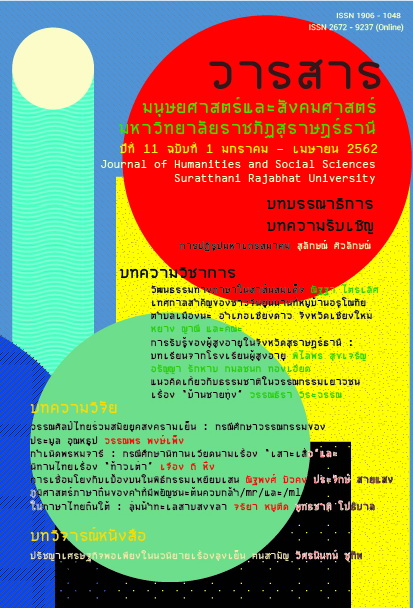The Immaculate Conception : A Case Study of Vietnamese Folktale “So Dua” and Thai Folktale “Thao Tao”
Main Article Content
Abstract
The research article explores the Immaculate Conception concept in both western and eastern mythologies. The article also considers the parallels between the Immaculate Conception motif in the Vietnamese folktale So Dua and the Thai folktale Thao Tao. The research reveals that the Immaculate Conception motif can be derived from not just mothers but also fathers and the natural environment, including such disparate elements as bonfires, lotus flowers and even rocks. In all cases where an Immaculate Conception has occurred, the male offspring is imbued with a renascent spirit, a higher spiritual quality, than is typically conferred on ordinary humanbeings. As such, the protagonists in such tales as So Dua and Thao Tao live in a state of summum bonum from which the very principle of goodness and all moral values are derived.
Article Details

This work is licensed under a Creative Commons Attribution-NonCommercial-NoDerivatives 4.0 International License.
All published manuscripts have been verified by peer-peer professors in the fields of humanities and social sciences. Reprinting of the article must be authorized by the editorial staff.
References
Ánh, N. (2014). 100 Vietnamese folktales. Hanoi: Culture and Information Publishing House.
Brown, M. (2009). The dance of 17 lives: The incredible true story of Tibet’s 17th Karmapa. Translated by Bunlaya. Bangkok: Parbpim Printing.
Bumrung Baramee. (1999). “Thao Tao”. In The Northern Thai Culture Encyclopedia, No. 6, pp. 2781 - 2785. Bangkok: Siam Press Management. (In Thai)
Cambell, J. and Moyers, B. (2008). The Power of Myth (2nd ed.). Translated by Baranee Boonsong. Nonthaburi: Amarin Printing and Publishing.
Ch'êng-ên, W. (1970). Monkey: Folk Novel of China. Translated by Waley, A.. New York: Grove Press.
Chi, N.D. (2000). Vietnamese folktales. Hanoi: Educational Publishing House.
Hang, T.T. (2015). A Comparative Study of the Belief “Reincarnation” in Vietnamese folktale “Tam Cam” and Thai folktale “Nang Uththra”. Proceedings Srinakharinwirot Research 2. Bangkok: Srinakharinwirot University. pp.105 - 116.
Kingkaew Attagara. (2015). Some articles used in teaching folklore. Phitsanulok: Naresuan University. (InThai)
Kukrit Pramoj, M.R.W. (2010). Lai Jivit (12th ed). Bangkok: Dokya. (In Thai)
Plato. (2010). Symposium. Translated by Kingkaew Attagara. Nonthaburi: Amarin Printing and Publishing.
Plato. (2012). Republic (2nd ed.). Translated by Waethus Bodharamix. Bangkok: Tubnangseu.
Swami Praphananda and Manchester, F. (2010). Upanishads. Translated by Kingkaew Attagara. Nonthaburi: Amarin Printing and Publishing.
Sathira Koses - Nagapradipa. (2009). The Pilgrim Kamanita (8thed.). Bangkok: Siam Printing. (In Thai)
Sowaluck Anantasant. (2000). A Comparative Study of Tale Type 510: Cinderella in the Western and the Eastern Societies. Bangkok:
Ramkhamhaeng University. (In Thai)
Swami Praphananda. (2001). The Book of The Secrets 1. Translated by Pichat Wonwith. Bangkok: Komol Publishing. (In Thai)
Saksi Yaemnatda. (2004). Indian Tales. Bangkok: Parbpim. (In Thai)
The Royal Institute of Thailand. (2013). Thai Dictionary by the Royal Institute 2013 (2nd ed.). Bangkok: Nanmee books Publications.
(In Thai)
Yogananda, P. (2011). Autobiography of a Yogi. Nonthaburi: Amarin Printing and Publishing.


